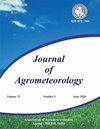Developing weather-based biomass prediction equation to assess the field pea yield under future climatic scenario
Q3 Agricultural and Biological Sciences
引用次数: 0
Abstract
The present research focuses on the variation of field pea production under different prevailing weather parameters, aiming to develop a reliable forecasting model. For that a field experiment was conducted in New Alluvial Zone of West Bengal during 2018-19 and 2019-20 with three different varieties (VL42, Indrira Matar, Rachana) of this region. Biomass predicting equation based on maximum temperature, minimum temperature and solar radiation was developed to estimate field pea yield for 2040-2099 period under SSP 2-4.5 and SSP 5-8.5 scenarios. It reveals that solar radiation positively influences crop biomass, while high maximum and minimum temperatures have adverse effects on yield. The developed forecasting equation demonstrated its accuracy (nRMSE=17.37%) by aligning closely with historical data, showcasing its potential for reliable predictions. Furthermore, the study delves into future climate scenarios, showing that increasing temperatures are likely to impact field pea yield negatively. Both biomass and yield showed decreasing trend for the years from 2040 to 2099. SSP 5-8.5 scenario, which is more pessimistic one, foresees a substantial reduction in crop productivity. This weather parameter-based biomass prediction equation can be effectively utilized as a method to assess the impact of climate change on agriculture. Keywords: Field pea, weather parameters, crop yield prediction, New Alluvial Zone, nRMSE开发基于天气的生物量预测方程,以评估未来气候条件下的大田豌豆产量
本研究重点关注不同天气参数下大田豌豆产量的变化,旨在开发一个可靠的预测模型。为此,2018-19 年度和 2019-20 年度在西孟加拉邦新冲积区进行了田间试验,使用了该地区的三个不同品种(VL42、Indrira Matar 和 Rachana)。根据最高温度、最低温度和太阳辐射建立了生物量预测方程,以估算 2040-2099 年 SSP 2-4.5 和 SSP 5-8.5 情景下的大田豌豆产量。结果表明,太阳辐射对作物生物量有积极影响,而较高的最高气温和最低气温则对产量有不利影响。所开发的预测方程与历史数据密切吻合,证明了其准确性(nRMSE=17.37%),展示了其进行可靠预测的潜力。此外,研究还深入探讨了未来的气候情景,表明气温升高可能会对大田豌豆产量产生负面影响。从 2040 年到 2099 年,生物量和产量都呈下降趋势。比较悲观的 SSP 5-8.5 情景预测作物产量将大幅下降。这一基于气象参数的生物量预测方程可作为评估气候变化对农业影响的有效方法。关键词大田豌豆 气象参数 农作物产量预测 新冲积区 nRMSE
本文章由计算机程序翻译,如有差异,请以英文原文为准。
求助全文
约1分钟内获得全文
求助全文
来源期刊

Journal of Agrometeorology
农林科学-农艺学
CiteScore
1.40
自引率
0.00%
发文量
95
审稿时长
>12 weeks
期刊介绍:
The Journal of Agrometeorology (ISSN 0972-1665) , is a quarterly publication of Association of Agrometeorologists appearing in March, June, September and December. Since its beginning in 1999 till 2016, it was a half yearly publication appearing in June and December. In addition to regular issues, Association also brings out the special issues of the journal covering selected papers presented in seminar symposia organized by the Association.
 求助内容:
求助内容: 应助结果提醒方式:
应助结果提醒方式:


